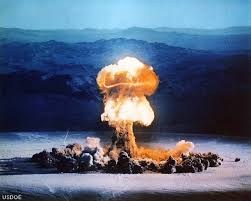 The producers of PBS’s new special “The Bomb” could not have predicted the current furor over the Iran nuclear deal while they were making their two-hour documentary, whose airing was timed to coincide with the 70th anniversary of the detonation of the atomic bomb.
The producers of PBS’s new special “The Bomb” could not have predicted the current furor over the Iran nuclear deal while they were making their two-hour documentary, whose airing was timed to coincide with the 70th anniversary of the detonation of the atomic bomb.
Yet since its inception, the bomb and its terrifying destructive power have never been far from the headlines, the minds of world leaders or the imagination of the public.
“The Bomb” takes viewers behind the scenes of the development of the first atomic bomb during World War II with the Manhattan Project and how it changed history and reshaped global politics.
But for those who did not live through the Cold War and the constant fear of a U.S.-Soviet nuclear war, the film will bring the era graphically to life.
The documentary uses rare footage from detonation tests from the 1950s and 60s that show the awesome power of nuclear explosions. With interviews from diplomats, historians, scientists, weapons designers, pilots and those who lived and worked with the atomic bomb, the film focuses on the choices society has made up until the present day to live with an invention that could destroy the planet.
“These explosions are horrible and horrific but there’s a strange irony that they’re visually compelling and almost beautiful in a way,” writer and director Rushmore DeNooyer said in a phone interview. “I’m a history buff, but I didn’t know much of anything after the war ended. I found the whole story a lot more compelling.”
DeNooyer said he always knew about Robert Oppenheimer, heralded as the father of the bomb, but not much about Leslie Groves, the general whom Oppenheimer worked with in tandem to develop the weapon.
Beginning in 1942, the basic atomic bomb research was carried out–mainly at Columbia University and the University of Chicago–and then project plants were established at Oak Ridge, Tenn., Hanford, Wash. and the secluded Los Alamos installation in northern New Mexico.
“Oppenheimer and Groves were opposites, but they worked together perfectly to get it done. I didn’t know how quickly things turn dark – very dark,” he said. “They were racing to prevent Hitler from getting the bomb. But Germany surrenders, and the bomb is ready three to four months later. They never set out to use it against Japan. They started debating the whole idea of what it would take for Japan to surrender. A lot of people don’t understand how difficult it was. There’s controversy today: would they surrender if we allowed them to keep the Emperor, which we did. And the 50th anniversary of the bombing in Hiroshima and Nagasaki turned into a huge controversy there.”
After three years of feverish work on the weapon by the military, there was huge momentum to use it. “It’s not fair to judge with the benefit of hindsight,” DeNooyer said. “In 1945, they didn’t know much about the effects. A lot of them thought it was just a bigger bomb–just one bomb and one airplane, in their minds.”
The bombings of the Japanese cities of Hiroshima and Nagasaki, which killed 129,000 people in attacks three days apart, remain the only instances in which nuclear weapons have been used in warfare.
As a viewer, it’s staggering to watch the video of nuclear tests with witnesses who are apparently unaware of the effects of radiation. It’s shocking to learn the U.S. Navy detonated underwater nuclear explosions without much knowledge of the contamination of its ships, the ocean and the effects on crew members.
“In the summer of 1946, events happened at lightning speed. In June, we proposed total nuclear disarmament but that broke down in arguments between the Americans and the Soviets,” DeNooyer said. “In July, with the first public test off the island of Bikini, the Navy wanted to prove that it was still relevant. They exploded two bombs, an environmental disaster, and a painful lesson. Ships were covered with radioactive steam, and no one had planned for that.”
The anti-nuclear movement can be traced to August 1946, when The New Yorker magazine devoted an entire issue to a 31,000 word essay called “Hiroshima” by John Hersey, which gave the public its first highly detailed look at what life was like for those who survived a nuclear bomb –and created arguments about it which we are still having today.
Memories of “duck and cover” drills, bomb shelters and the Cuban Missile Crisis still resonate with many Americans, but the Cold War ended, the Berlin Wall came down and for a time, it seemed like nuclear danger was at bay.
“But it’s still there and just as dangerous and horrific as it always was,” DeNooyer said. “The number of weapons has been reduced, although we still have thousands, and we don’t have bombers circling Russia. But with India and Pakistan having the bomb, a small nuclear war could happen and end up using 30 or 40 bombs which would affect the climate of the whole planet, produce crop destruction and a huge amount of smoke and a tremendous amount of heat. Cities would be burned. Hiroshima was set on fire by the bomb. With nuclear bombs, you don’t get a second chance.”
DeNooyer spent a year and a half working on the documentary and said, “I really want people to see it and get a sense of the huge epic story of the bomb.”
(“The Bomb” premieres on PBS Tuesday, July 28 at 8 p.m. ET– check local listings.)

